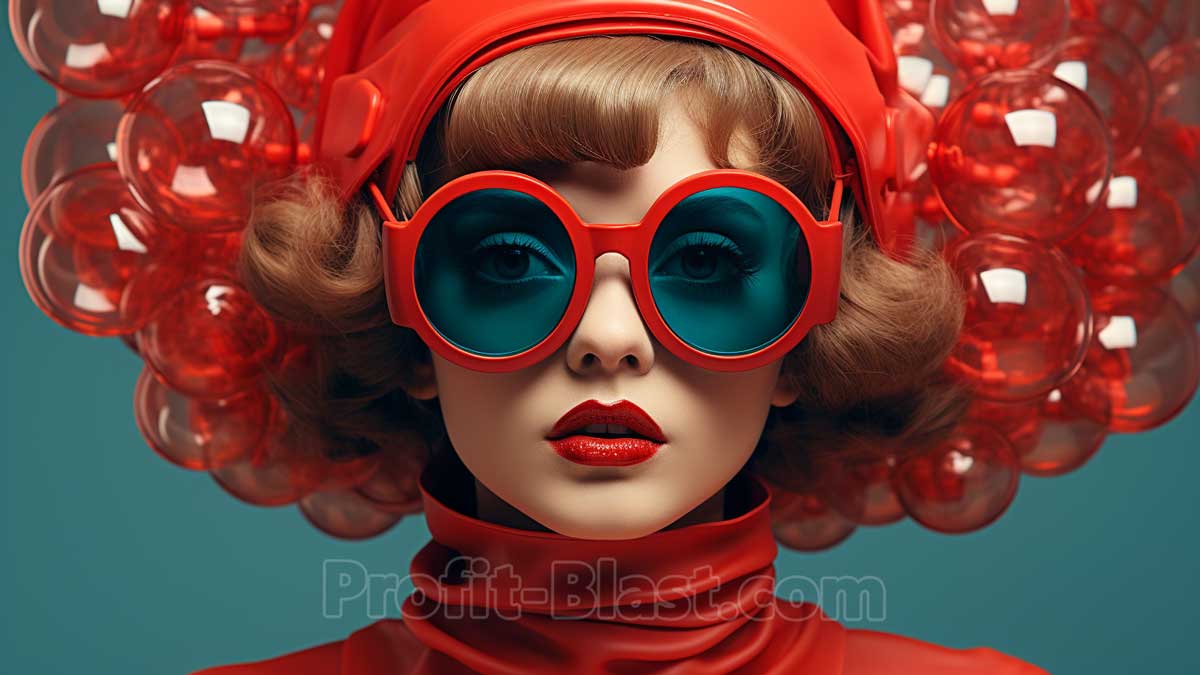How to Start a Fashion Blog and Make Money
– Updated December 09, 2023

Welcome to Profit-Blast, your Ultimate Blog for Passive Income and Earning Money from Home. In this Blog, we explain How to Create a Fashion Blog and Make Money. Let’s go.
Introduction
Are you passionate about fashion and eager to share your unique style with the world? Starting a fashion blog can be a fulfilling and profitable venture.
In this guide, we will take you through the step-by-step process of launching a successful fashion blog and monetizing it effectively. So, if you’re ready to turn your fashion passion into a thriving online business, let’s dive in!
Why Start a Fashion Blog?
Before we jump into the practical steps, let’s explore why starting a fashion blog can be a rewarding endeavor. Here are a few compelling reasons:
Share your personal style: If you’re already immersed in the fashion world and have a keen eye for the latest trends, starting a blog allows you to showcase your personal style and inspire others.
Connect with like-minded individuals: Blogging provides an opportunity to connect with fellow fashion enthusiasts, industry professionals, and potential collaborators. Building a community around your blog can be immensely fulfilling.
Establish yourself as an authority: By consistently delivering informative and engaging content, you can position yourself as an authority in the fashion industry. This can open doors to exciting opportunities such as collaborations, brand partnerships, and even consulting gigs.
Monetize your passion: One of the biggest advantages of fashion blogging is the potential to generate income. With strategic planning and the right approach, you can monetize your blog through various channels such as affiliate marketing, sponsored content, and creating and selling your own products.
Now that we’ve established the benefits of starting a fashion blog, let’s dive into the practical steps to get you started.
Choose Your Fashion Blog Niche
To stand out in the crowded blogosphere, it’s crucial to define your fashion blog niche. While fashion is a broad subject, narrowing down your focus will help you attract a more targeted audience.
Consider your personal interests, unique perspectives, and areas of expertise within the fashion industry.
Here are a few niche ideas to consider:
Sustainable fashion: Focus on eco-friendly and ethical fashion choices, sharing tips on sustainable shopping and styling.
Vintage fashion: Explore the world of vintage clothing and accessories, offering guidance on where to find unique pieces and how to style them.
Streetwear: Dive into the urban fashion scene, covering the latest streetwear trends, collaborations, and style inspiration.
High-end luxury: Cater to fashion enthusiasts with a taste for luxury brands, providing insights into high-end fashion collections, runway shows, and luxury lifestyle.
Remember, choosing a niche doesn’t mean you can’t expand in the future. It simply allows you to establish a strong foundation and grow your blog with a specific target audience in mind.
Select a Memorable Domain Name

Once you’ve defined your fashion blog niche, it’s time to choose a memorable domain name. Your domain name is your blog’s online address, so it’s essential to make it catchy, easy to remember, and relevant to your niche.
Consider incorporating keywords related to your fashion blog niche in your domain name. This can improve your blog’s visibility in search engine results and help potential readers understand what your blog is about at a glance.
Use domain name suggestion tools like Domainr or GoDaddy to check the availability of your desired domain name. Aim for a domain name with a .com extension, as it’s the most widely recognized and trusted domain extension.
Set Up Your Fashion Blog Hosting
To make your fashion blog accessible to the world, you’ll need reliable web hosting. A web host is a service that stores your blog’s files and makes them available for visitors to access.
When it comes to hosting your fashion blog, we recommend choosing a reputable and affordable hosting provider like Hostinger. Hostinger offers fast and secure hosting services, making it an excellent choice for bloggers.
Plus, they provide a free domain name registration, which is a great cost-saving benefit.
To set up your fashion blog hosting with Hostinger, follow these simple steps:
1. Visit the Hostinger website and choose a hosting plan that suits your needs. The Single Shared Hosting plan is a cost-effective option for beginners.
2. Register a new domain or connect an existing domain to your Hostinger account.
3. Complete the registration process and set up your account.
4. Install WordPress using Hostinger’s user-friendly control panel. WordPress is a popular content management system that powers millions of websites and blogs worldwide.
Congratulations! You’ve successfully set up your fashion blog hosting. Now, let’s move on to the next step.
Install a Fashion-Friendly WordPress Theme

With WordPress installed, it’s time to choose a visually appealing and fashion-friendly theme for your blog. A theme determines the overall look and feel of your blog, so it’s important to select one that aligns with your fashion niche and reflects your brand identity.
You can find a wide range of free and premium WordPress themes tailored specifically for fashion blogs. Websites like Etsy offer a variety of professionally designed themes at affordable prices.
Look for themes that are mobile-responsive, customizable, and optimized for SEO (search engine optimization).
When selecting a theme, consider the following factors:
Visual appeal: Choose a theme that complements your fashion niche and resonates with your target audience. Look for clean and visually appealing designs that showcase your content effectively.
Customization options: Ensure that the theme offers customization options so you can personalize your blog’s appearance and make it unique.
Responsiveness: With the majority of internet users accessing websites from mobile devices, it’s crucial to choose a theme that is mobile-friendly and provides an optimal viewing experience across various screen sizes.
SEO optimization: Look for themes that are SEO-friendly, as this can significantly impact your blog’s visibility in search engine results.
Once you’ve selected a theme, install it on your WordPress dashboard by navigating to “Appearance” > “Themes” > “Add New” and selecting the theme file you downloaded.
Customize Your Fashion Blog Design
Now that you have your theme installed, it’s time to customize your fashion blog design to make it visually appealing and aligned with your brand. Customization options may vary depending on the theme you’ve chosen, but here are a few key elements to consider:
Logo and branding: Create a unique logo that represents your fashion blog’s identity. Use colors, fonts, and graphics that reflect your brand’s style and resonate with your target audience.
Color palette: Select a cohesive color palette that complements your fashion niche and creates a visually appealing experience for your readers.
Typography: Choose fonts that are easy to read and align with your blog’s aesthetic. Consider using different font styles for headings, subheadings, and body text to create visual hierarchy.
Layout and navigation: Customize your blog’s layout to make it user-friendly and intuitive. Ensure that your readers can easily navigate through your content and find what they’re looking for.
Images and visuals: Use high-quality and visually appealing images that enhance your blog’s overall aesthetic. Optimize your images for web to ensure fast loading times.
Remember, consistency is key when it comes to design. Keep your design elements consistent across your blog to create a cohesive and professional look.
Need Ideas to Start a Business?
Check Out these Amazing Home Income Ideas
Craft Engaging and Informative Content

Now that your fashion blog is set up and visually appealing, it’s time to focus on creating engaging and informative content. The success of your blog relies heavily on the quality of your content, so it’s important to deliver valuable and compelling posts consistently.
Here are some content ideas to get you started:
Style inspiration: Share your own outfit ideas and fashion inspirations to inspire your readers and help them create stylish looks.
Trend analysis: Keep your audience updated on the latest fashion trends and provide insights into how they can incorporate these trends into their personal style.
Shopping guides: Curate lists of must-have fashion items, seasonal picks, or budget-friendly options to help your readers make informed purchasing decisions.
How-to guides: Create step-by-step tutorials on fashion-related topics such as styling tips, fashion hacks, or DIY projects.
Brand collaborations: Partner with fashion brands for sponsored content, product reviews, or giveaways. Be selective and choose brands that align with your blog’s niche and values.
Remember to create content that is unique and offers value to your readers. Develop your own voice and storytelling style to stand out in the saturated blogosphere.
Promote Your Fashion Blog
Creating high-quality content is just the first step. To attract readers to your fashion blog and increase your visibility, you need to promote your content effectively. Here are some promotion strategies to consider:
Social media marketing: Leverage popular social media platforms like Instagram, Pinterest, and Facebook to share your blog posts, engage with your audience, and build a following. Tailor your content to each platform and use relevant hashtags to reach a wider audience.
Collaborate with influencers: Partner with influencers or fellow fashion bloggers in your niche to cross-promote each other’s content and expand your reach. This can help you tap into their established audience and gain exposure.
Guest posting: Write guest posts for other fashion blogs or websites to showcase your expertise and build backlinks to your own blog. This can improve your blog’s visibility in search engine results and drive traffic to your site.
SEO optimization: Implement SEO best practices to improve your blog’s visibility in search engine results. Conduct keyword research to identify popular search terms in your fashion niche and incorporate them into your blog posts, titles, and meta descriptions.
Remember to engage with your readers and respond to their comments and messages. Building a community around your blog is essential for long-term success.
Monetize Your Fashion Blog

Now that your fashion blog is gaining traction and attracting an audience, it’s time to explore monetization opportunities. Here are some popular ways to make money from your fashion blog:
Affiliate marketing: Join affiliate programs and promote products or services that align with your fashion niche. Earn a commission for every sale or referral made through your affiliate links.
Sponsored content: Collaborate with brands for sponsored blog posts, product reviews, or social media campaigns. Ensure that the sponsored content aligns with your blog’s niche and resonates with your audience.
Advertisements: Display ads from ad networks like Google AdSense or Mediavine on your blog to generate revenue based on impressions or clicks.
Selling your own products/services: Create and sell your own fashion-related products or services, such as e-books, online courses, styling services, or merchandise. This allows you to leverage your expertise and monetize your knowledge.
Remember to disclose any sponsored content or affiliate links to maintain transparency with your audience. Building trust is crucial for long-term success in the blogging industry.
Analyze and Optimize
To continuously improve your fashion blog’s performance and maximize its potential, it’s essential to analyze your blog’s metrics and make data-driven decisions. Here are some key metrics to track:
Website traffic: Monitor your blog’s overall traffic, including the number of unique visitors, page views, and bounce rate. Identify trends and patterns to understand what content resonates the most with your audience.
Audience engagement: Measure engagement metrics such as comments, social media shares, and time spent on your blog. This indicates how well your content is resonating with your readers and helps you identify areas for improvement.
Conversion rates: Track how effectively your blog is converting visitors into subscribers or customers. Monitor your email sign-ups, affiliate link clicks, or product/service sales to gauge your blog’s conversion rate.
Use analytics tools like Google Analytics to gain insights into your blog’s performance and identify areas for optimization. Experiment with different strategies and content formats to drive engagement and conversions.
Stay Consistent and Keep Evolving

Consistency is key when it comes to blogging. Commit to a regular posting schedule and stick to it. Whether it’s once a week or multiple times a week, consistency builds trust with your audience and helps you establish your blog as a reliable source of fashion content.
As you continue on your blogging journey, stay open to learning and evolving. Keep up with the latest fashion trends, industry news, and technology advancements. Embrace new platforms and mediums to reach your audience effectively.
Remember, building a successful fashion blog takes time, effort, and persistence. Stay true to your unique voice, provide value to your readers, and enjoy the process of sharing your fashion passion with the world.
Now that you have a comprehensive guide on how to start a fashion blog and make money online, it’s time to take action. Start brainstorming your niche, choose a memorable domain name, set up your hosting, and let your fashion journey begin!
Disclaimer: The information provided in this article is for informational purposes only and should not be considered financial advice. Always consult with a professional advisor before making any investment decisions.
This blog may contain affiliate links, which means that if you click on certain links and make a purchase, we may earn a commission. This commission comes at no additional cost to you, and it helps support the blog, allowing us to continue providing valuable content. Rest assured, we only recommend products or services that we genuinely believe in and have personally tested or researched. Thank you for your support!

0 Comments